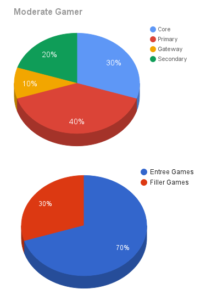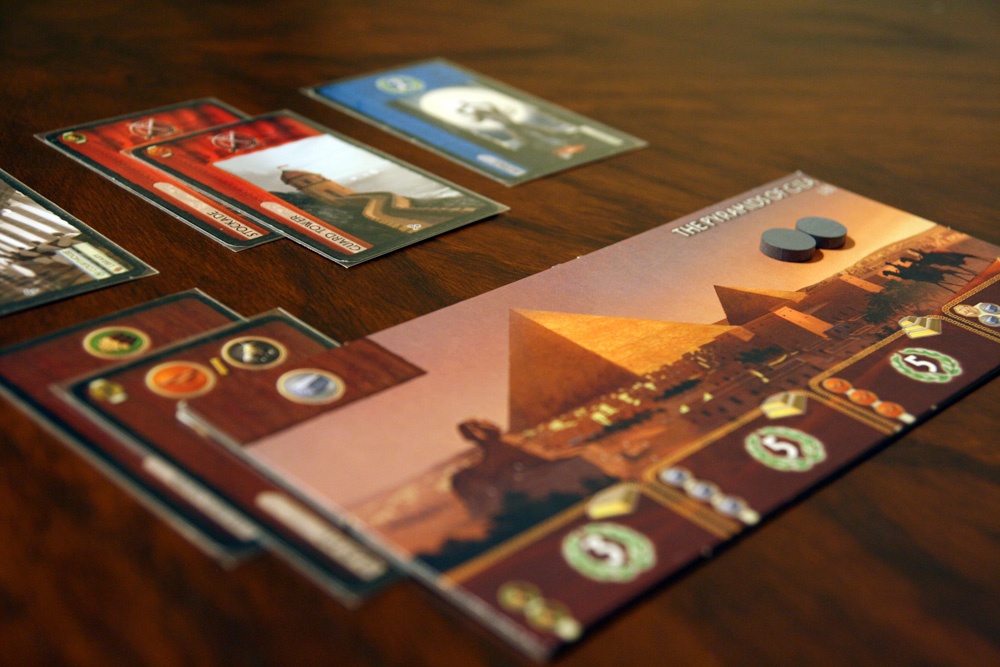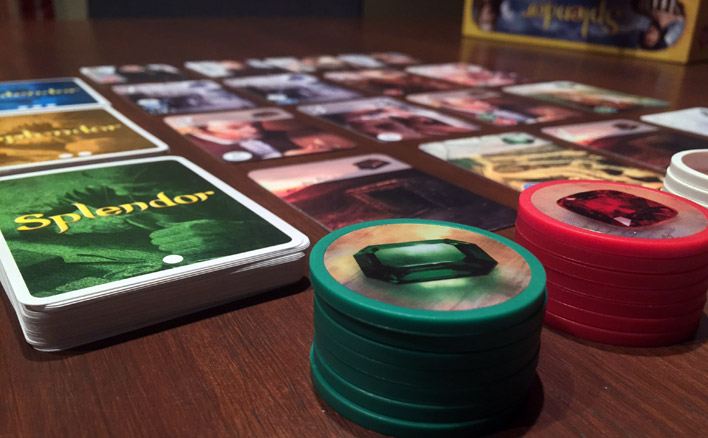One of the things that many gamers struggle with is how to manage a gaming collection. If you live by the mantra that games are meant to be played, then seeing a long row of unplayed games gathering dust on your shelves is depressing. Some people may collect games just for the having, but if you’re like me, having a game on your shelf means you want to play it at some point. The following article is meant to help players analyze their gaming habits so that games stay in rotation and get played frequently enough so that they’re never gathering dust.
Games most often don’t get played because the owner usually has too many games in their collection. They may be collecting games too fast to keep up with their play habits or they may tire of games quickly. By breaking down to a suggestion of what a game collection should look like, based on gaming frequency and the types of games people play, you can get a better sense for what kind of games to keep in your collection.
Categories of Games as Relates to a Collection
Within a gaming group, it’s very common to either have gamers who bring games or who tend to show up to play the zeitgeist title of the evening. Often this means that, depending on the length of time available for play, a few different types of games can be enjoyed. There are some games that are meant to be the highlights of the evening. Much like a main course, I like to call these “entree” games. Other, much shorter games are the “fillers” that are played between entrees, or are there to occupy time while waiting for another group to finish their game.
Games tend to fall into a few of different categories based on what they mean to the owner, how they are engaged and the overall popularity.
Core Games: These are the games you love the most no matter the type. You know the rules inside and out and are always ready to teach. No matter the BoardGameGeek rating, these games are your friends.
Primary Games: These are good entrees for most gamers. Most have great mechanisms, but the experience isn’t necessarily one that you want to have over and over. You could teach these with a quick refresher. Usually, these are the highest rated games on BoardGameGeek.
Secondary Games: Here are games that excel with specific, unusual mechanisms or unique scoring. They might also need a certain number of players or a certain type of player. Likely you’ll need to review the rules of these the night before you play. Usually they don’t have the higher ratings on BoardGameGeek.
Gateway Games: If a game falls in this category, it’s easy enough that you only bring it out specifically when playing with new players. You should always be familiar enough with these games to teach them while glancing at the rules to make sure you’re getting them all right. Try to only keep gateway games that feature common mechanisms or that really deliver fun the way gaming is meant to make you feel.
Types of Gamers and Collection Breakdown
We can’t play games all the time. Some of us definitely have more time than others. If you need to assess an appropriate size to a game collection, it’s also necessary to judge how much time you devote to playing games and what groups you most often play with. By relating to one of the archetypes below, you’ll get a sense to judge your gaming spending.
The reasonable upper limit for games in a collection depends mostly on how often you play and how quickly you get tired of games. Collections of 400+ games are uncommon and most moderate to heavy gamers have around 100+ games. This is to accommodate a variety of situations.
The subtypes of games (party, strategy, adventure, word games) depend largely on your personal tastes and won’t be covered here. Suffice it to say, to make optimal use of the games, they should match what you and your group enjoy.
Family Gamer
 Gamers with younger children tend to fall in this category. Attention span and patience is an issue so gaming is more infrequent. Also, kids newer to gaming may make frequent appearances so keeping gateway games handy is key. There’s no need for filler games because gaming sessions are shorter.
Gamers with younger children tend to fall in this category. Attention span and patience is an issue so gaming is more infrequent. Also, kids newer to gaming may make frequent appearances so keeping gateway games handy is key. There’s no need for filler games because gaming sessions are shorter.
Gaming Frequency: Once a week, 1-2 hours
Number & Ages: 3-4 players, ages 8+
Collection Size: 10-30 games in collection
- 50% core, 30% primary, 20% gateway
- 100% non filler
Casual Gamer
 Those who enjoy board games but don’t make it a priority in their lives are casual gamers. They play with friends or coworkers, thus needing a significant percentage of primary and gateway games. Their core games are also near-primary in status, none of which venture into heavy territory. The main thing differentiating the casual from the family collection are the ages required for most games.
Those who enjoy board games but don’t make it a priority in their lives are casual gamers. They play with friends or coworkers, thus needing a significant percentage of primary and gateway games. Their core games are also near-primary in status, none of which venture into heavy territory. The main thing differentiating the casual from the family collection are the ages required for most games.
Gaming Frequency: Once a week, 2-3 hours
Number & Ages: 2-8 players, ages 12+
Collection Size: 20-50 games in collection, few unplayed
- 50% core, 30% primary, 20% gateway
- 80% non filler, 20% filler
Moderate Gamer
 When board gaming starts to be something scheduled for, you’re into moderate gamer territory. These gamers have a wide variety of games in their collections to accommodate a wide variety of gaming situations.
When board gaming starts to be something scheduled for, you’re into moderate gamer territory. These gamers have a wide variety of games in their collections to accommodate a wide variety of gaming situations.
Gaming Frequency: Twice a week, 2-3 hours each time
Number & Ages: 3-6 players, ages 16+
Collection Size: 50-100 games in collection, some unplayed
- 30% core, 40% primary, 20% secondary, 10% gateway
- 70% non filler, 30% filler
Heavy Gamer
 If you have decided gaming takes the priority in your free time, you’re a heavy gamer. Time is primarily occupied with your favorite core games occasionally drawing out a primary or a gateway should a family member drop by.
If you have decided gaming takes the priority in your free time, you’re a heavy gamer. Time is primarily occupied with your favorite core games occasionally drawing out a primary or a gateway should a family member drop by.
Gaming Frequency: Three or more times a week, 2-3 or 4+ hours each time
Number & Ages: 3-5 players, ages 18+
Collection Size: 80+ games in collection, many unplayed
- 60% core, 30% primary, 10% gateway
- 90% non filler, 10% filler
Conclusion
Maybe you’re thinking of expanding your game collection. Maybe you’re about to hit “Submit Order” on Amazon with 10 games in your cart. The truth is, unless you have unlimited time, money, and friends with unlimited time, you need to manage your game collection. How you approach that is almost a game in itself but analyzing the profiles above is a great place to start.























I like your methodology. I used to be a moderate gamer, but had 4 kids and have become a family gamer. I’m working my way back into moderate gaming territory
Sounds good. I was in that same boat myself a few years ago.
Conclusion : heavier gamer you are more games are on your shelve unplayed. Lighter gamer you are more games are unplayed 🙂
Funny right?
Have you posted some where your personal breakdown?
I have heard of this upcoming game called LAGIM. It’s a strategy game for friends and family to enjoy. You could add it to one of your collection. Watch the teaser trailer here. https://www.facebook.com/LAGIMGAME/videos/254651272216362/